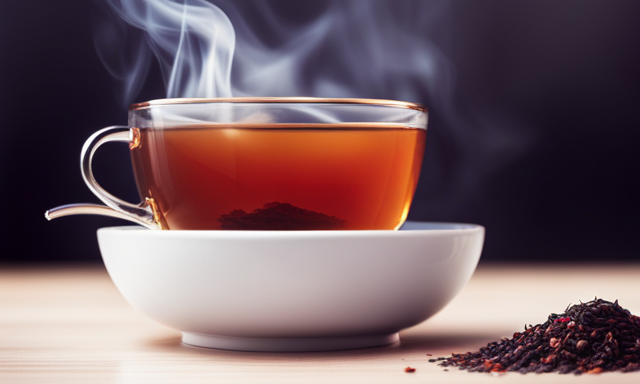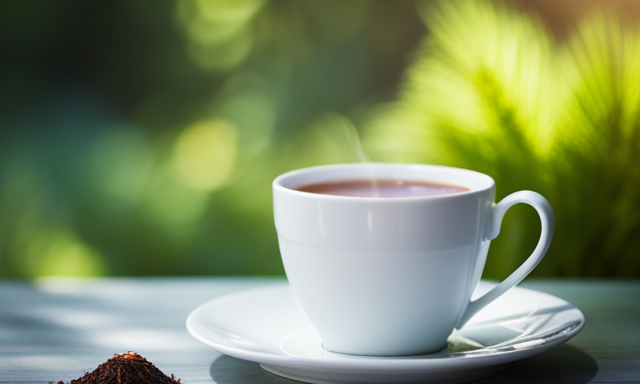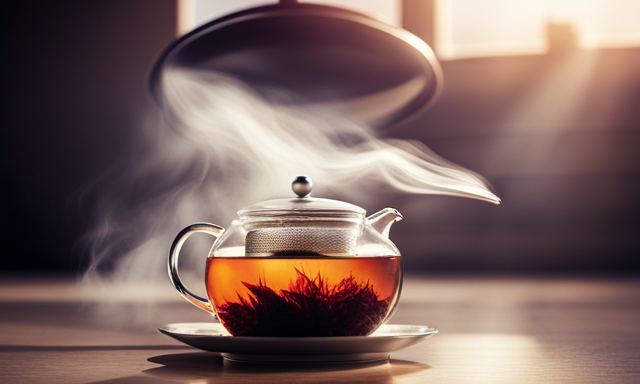Have you ever wondered what rooibos tastes like?
Picture this: you’re sitting in a cozy café, enjoying a warm cup of tea. The rich aroma fills the air, inviting you to take that first sip. As the smooth, velvety liquid touches your lips, a burst of flavor dances on your tongue. It’s a unique and delightful experience, one that leaves you craving more. That’s the magic of rooibos.
In this article, we will explore the taste profile of rooibos tea. We’ll delve into its origins, the process of making it, and the various flavor notes that make it truly special. From earthy and woody undertones to hints of sweetness and fruitiness, rooibos offers a diverse range of flavors to tantalize your taste buds. Whether you’re a tea enthusiast or someone curious about trying something new, this article will guide you through the wonderful world of rooibos and help you understand why it has gained popularity among tea lovers worldwide.
So, let’s embark on this flavorful journey together and discover the delightful taste of rooibos.
Key Takeaways
- Rooibos tea has a naturally sweet and earthy flavor with floral undertones such as lavender, rose, and chamomile.
- It complements a wide range of dishes, enhancing the flavors of roasted meats, cheese platters, spicy dishes, fruits, chocolate, and creamy desserts.
- Rooibos tea is caffeine-free and rich in antioxidants, promoting skin health, supporting a healthy immune system, and potentially having anti-inflammatory properties.
- Its versatility makes it a delightful addition to any wellness routine, adding depth and complexity to both savory dishes and desserts.
Origins and Cultivation of Rooibos
So, you’re probably wondering where this delicious tea comes from and how it’s grown, right? Well, let me tell you all about the origins and cultivation of Rooibos!
Rooibos tea production is a fascinating process that starts in the Western Cape province of South Africa. This unique tea is harvested from the Aspalathus linearis plant, which thrives in the region’s sandy soil and Mediterranean climate.
Rooibos farming techniques have been perfected over generations, with careful attention to detail and sustainable practices. The plants are meticulously tended to, ensuring optimal growth and flavor development.
Once the leaves are harvested, they undergo a fermentation process that gives Rooibos its signature reddish-brown color and distinct taste.
This brings us to the next section, where we will delve into the process of making rooibos tea without skipping a beat.
The Process of Making Rooibos Tea
To truly savor the rich flavor of rooibos tea, imagine yourself whisked away to the enchanting process of its creation. Here’s a step-by-step guide to understanding how rooibos tea is made:
-
Harvesting: The needle-like leaves of the Aspalathus linearis plant are carefully handpicked, ensuring only the finest leaves are selected.
-
Fermentation: After harvesting, the leaves undergo a natural fermentation process, where they’re moistened and left to oxidize. This crucial step enhances the flavor and aroma of the tea.
-
Drying: The fermented leaves are spread out in the sun to dry, allowing them to retain their vibrant red color and develop their distinctive taste.
-
Blending: Once dried, the leaves are expertly blended to create different types of rooibos blends. From pure rooibos to flavored variations like vanilla or honey, there’s a blend to suit every palate.
Transitioning to the appearance of rooibos leaves and infusion, the meticulous process of creating rooibos tea ensures a truly delightful and aromatic experience.
The Appearance of Rooibos Leaves and Infusion
Imagine yourself admiring the vibrant red hue of the dried rooibos leaves as they infuse in hot water, releasing a captivating aroma that will transport you to a world of pure indulgence. The appearance of rooibos leaves is truly a sight to behold, with a color variation that ranges from a deep crimson to a rich amber. This natural variation in color adds a visual allure to the tea, making each cup a unique experience. To further illustrate this, I have created a table below showcasing the different shades of rooibos leaves and their corresponding infusion colors:
| Leaf Color | Infusion Color |
|---|---|
| Deep Crimson | Ruby Red |
| Rich Amber | Golden Brown |
| Rustic Red | Copper |
As you can see, the infusion color mirrors the hue of the leaves, creating a visually stunning brew. With the appearance captivating your senses, let us now delve into the aromatic wonders of rooibos tea.
The Aroma of Rooibos
Let the delightful aroma of rooibos envelop you like a warm embrace, transporting you to a realm of relaxation and tranquility.
The importance of scent in tea can’t be overstated, as it plays a significant role in our perception of taste. The enticing aroma of rooibos is both enchanting and inviting, with its earthy and slightly sweet notes. As I inhale its fragrance, I’m reminded of a sun-drenched African landscape, where the rooibos plant thrives.
The aroma of this herbal infusion sets the stage for the sensory experience that’s about to unfold. It prepares my taste buds for the rich, smooth, and naturally sweet flavors that await.
As we delve into the primary flavor notes of rooibos, let’s explore the captivating journey that this remarkable tea takes us on.
The Primary Flavor Notes of Rooibos
Experience the rich and delightful primary flavor notes of rooibos as they transport your taste buds to a realm of sweetness and earthiness.
-
Velvety smoothness: The primary flavor notes of rooibos evoke a sense of velvety smoothness, like a warm embrace for your palate. It coats your tongue with a soothing texture that lingers long after each sip.
-
Nutty undertones: Within the layers of rooibos, you’ll discover subtle nutty undertones, reminiscent of roasted almonds or hazelnuts. These delicate notes add depth and complexity to the overall flavor profile.
-
Honey-like sweetness: Rooibos is known for its natural sweetness, akin to the golden nectar of honey. Each sip carries a gentle sweetness that’s both comforting and indulgent.
As you savor the primary flavor notes and explore the health benefits of rooibos, it becomes evident that sweetness and natural sugars play a significant role in enhancing the overall experience.
Sweetness and Natural Sugars in Rooibos
Indulge in the delightful sweetness and natural sugars of rooibos, which research shows can help regulate blood sugar levels and promote a healthy metabolism.
As I take a sip of this aromatic infusion, I embark on a sweetness exploration that unravels the intricate flavors hidden within. The natural sugar content of rooibos adds a gentle, honey-like sweetness to the brew, enhancing its overall appeal. It’s fascinating to discover how this herbal tea can be naturally sweet without any added sugars or sweeteners.
The complexity of rooibos lies in its ability to balance this sweetness with other flavor elements, creating a harmonious taste experience. As I continue to explore the sensory journey of rooibos, I am eager to delve into its earthy and woody undertones, which add depth and richness to this remarkable beverage.
Earthy and Woody Undertones in Rooibos
As I take another sip, I’m captivated by the earthy and woody undertones of rooibos, adding a depth that dances on my palate. The earthy flavor of rooibos brings to mind the rich aroma of freshly fallen leaves, grounding me in the present moment.
This distinct characteristic sets rooibos apart from other teas, creating a unique experience for the senses.
In my exploration of various teas, I’ve come to appreciate the flavor comparison between rooibos and traditional black tea. While black tea often boasts a bold and robust taste, rooibos offers a subtler, more nuanced profile. Its earthy notes provide a gentle reminder of nature’s bounty, creating a soothing and comforting sensation with every sip.
Moving forward, let’s delve into the other flavor profiles and variations of rooibos, uncovering the delightful surprises that await us.
Other Flavor Profiles and Variations of Rooibos
Get ready to discover a world of tantalizing flavor variations and unexpected twists in your journey through the diverse taste profiles of rooibos. While the earthy and woody undertones are certainly a hallmark of this South African herbal tea, there’s so much more to explore.
Rooibos can also offer subtle floral undertones that add a delicate and aromatic touch to its flavor profile. These floral notes provide a refreshing and uplifting experience, making rooibos a perfect choice for those seeking caffeine-free alternatives. Whether it’s a hint of lavender, rose, or chamomile, these floral undertones enhance the overall drinking experience and create a sense of tranquility.
Now, let’s transition into the next section about pairing rooibos with food and desserts, where we’ll explore the delightful combinations that can elevate your culinary adventures.
Pairing Rooibos with Food and Desserts
Savor the delightful dance of flavors as rooibos tea effortlessly waltzes with a variety of foods and desserts, creating a symphony of culinary pleasures. The versatility of rooibos makes it an ideal companion for both savory dishes and sweet treats. Its earthy and slightly sweet taste pairs beautifully with roasted meats, cheese platters, and spicy dishes, adding depth and complexity to every bite. On the other hand, when paired with desserts, rooibos brings out the natural sweetness of fruits, chocolate, and creamy desserts, elevating their flavors to new heights. Not only does rooibos enhance the dining experience, but it also offers numerous benefits for skin health. Its antioxidant properties help combat free radicals, promoting a youthful and radiant complexion. As we explore the health benefits and conclusion, we will uncover even more reasons to indulge in this exquisite tea.
Health Benefits and Conclusion
Discover the amazing ways rooibos tea can improve your health and leave you feeling rejuvenated and refreshed.
Rooibos tea, with its distinct taste and health benefits, is a delightful addition to any wellness routine. The tea is caffeine-free, making it a soothing option for those looking to reduce their caffeine intake.
Rooibos is also rich in antioxidants, which help protect the body against free radicals and support a healthy immune system. Additionally, studies have shown that rooibos tea may have anti-inflammatory properties, which can aid in reducing inflammation and promoting overall well-being.
Its naturally sweet and earthy flavor makes it a versatile choice for both hot and iced beverages. Whether enjoyed on its own or blended with other herbs and spices, rooibos tea offers a unique and satisfying taste experience while providing numerous health benefits.
Frequently Asked Questions
Can rooibos tea be consumed by individuals with certain health conditions?
Individuals with heart conditions may benefit from the consumption of rooibos tea, as it has been shown to have heart-protective properties. Similarly, rooibos tea can also be soothing for those with digestive disorders.
Are there any known side effects or potential risks associated with drinking rooibos tea?
There are no known major side effects of drinking rooibos tea, making it generally safe for consumption. However, it’s always best to consult with a healthcare professional before giving it to children.
Can rooibos tea be enjoyed both hot and cold, or is it typically served in a specific way?
Rooibos tea can be enjoyed both hot and cold, allowing for versatility in serving. It offers a range of flavor variations, from earthy and nutty to sweet and floral, making it a delightful choice for any occasion.
Does rooibos tea contain caffeine, or is it naturally caffeine-free?
Rooibos tea, naturally caffeine-free, offers a plethora of health benefits. It’s a soothing beverage that nourishes the body and calms the mind. Its caffeine content is negligible, making it perfect for relaxation and unwinding.
Are there any specific brewing instructions or recommended steeping times for preparing the perfect cup of rooibos tea?
When it comes to brewing techniques for rooibos tea, it’s important to use water that has been heated to just below boiling point. Steeping it for 5-7 minutes allows the rich, earthy flavor profiles to fully develop.
Conclusion
In conclusion, after delving into the origins, cultivation, and flavor profile of the delightful rooibos tea, it’s evident that this South African gem is a true embodiment of nature’s wonders.
With its earthy and woody undertones, rooibos captivates the senses and offers a unique and gratifying experience. Its versatility in pairing with various foods and desserts further enhances its appeal.
So, dear reader, why not embark on a journey to savor the richness of rooibos, and let its warmth and complexity envelop you in a world of pure indulgence? After all, life’s too short to miss out on the extraordinary pleasures that rooibos has to offer.










